Hello everyone,
Welcome to Issue #72 of CAFÉ ANNE!
I was so pleased when my efforts to solve the mystery of Mehran’s Steak House, related in last week’s issue, spurred several readers to do some sleuthing of their own. Thanks to their efforts, I’m hot on the trail. Stay tuned!
In other news, last week’s guest post from child-free Aharon spurred some interesting speculation. “I’m pretty sure your ‘friend’ ‘Aharon’ is a creation of AI,” emailed reader Forrest in Providence. “He seems like a real chatbot to me. AI can do anything, including create writers for CAFÉ ANNE.”
As I noted in my reply to Forrest, I have long harbored the same suspicion. And when I posed the question directly to Aharon, he freely admitted to being an AI-generated creation. Which is exactly the sort of disingenuous counter-trickery you’d expect of a rogue bot!
Aharon’s post also prompted the following email query from reader Therry N. in Roanoke, VA:
“Thank you kindly for including childless Aharon's advice for raising children! He sounds like my kinda guy. Would you ask him if he has any interest in adopting me? Bonuses: I have my own health insurance. I don't drive or drink. I have my own cellphone. I'm married.”
I forwarded her request to “Aharon.” The response:
Dear Ms. N.:
We read with interest and enthusiasm your kind offer to become an Aharon Adoptee™.
However, for tax purposes, Aharon is a dependent of Horatia, the dried alligator pictured in CAFÉ ANNE issue #71. We will discuss possible courses of action and update as necessary.
Regards,
Management
Fingers crossed, Therry!
In other news, I would like to do a mini feature highlighting New Yorkers who use their ovens as storage units—a weird quirk of living in a city where few people cook and no one has enough closet space. Is this you? Please send a photo of your oven’s interior to annekadet@yahoo.com.
I am very excited about this week’s issue, of course. I’ve got a Q&A with CAFÉ ANNE reoccurring characters Jessi Highet and Mike Varley, discussing their latest project photographing and cataloguing more than 200 lost pet posters posted around NYC. Please enjoy.
Regards!
Anne
TOMBSTONE OF THE WEEK
FEATURE
Lost Pets of New York!
One of my favorite CAFÉ ANNE stories last year was "Meet NYC’s Most Bonkers Walkers" about a Bushwick couple, Jessi Highet and Mike Varley, who spent an entire year taking 26-mile daily walks through different city neighborhoods. That’s 7,025 miles, 13,954,700 steps and 506,000 calories burned.
But that wasn't the end of it. Along the way, they visited more than 200 bagel shops around town and subsequently launched Everything is Everything, an obsessively detailed site ranking and charting each shop on factors ranging from price and ambiance to the quality of its scallion cream cheese. And then, to fund their expedition, they turned their bagel portraits into digital images which they sold as NFTs. It was very 2022!
But the walk keeps giving. Last week, they launched "Lost Pets of New York", which catalogues the 230 lost pet posters they spotted and photographed across the five boroughs during their epic walk.
They've turned 200 of those photos into NFTs available for .01 ETH (roughly $18). But this time, they are donating all the proceeds to a charity—Rikers Island Cat Rescue—a nonprofit devoted to supporting a vast cat colony on the famous prison island. (If you ask me, all cats should be in jail, but to each his own.)
Last week, I reconnected with Jessi and Mike to learn about the Lost Pet project. The Q&A that follows has been edited and condensed. Please enjoy!
Why did you start taking photos of lost pet posters during your walk?
Mike: Each walk was an average of 9.5 hours a day. As you can imagine, that gives you a pretty big container to fill with different sub-projects, if you were so inclined.
You walk around the city, and you see these lost pet posters. Even if you keep an eye out, there's maybe a .01% chance you will see the animal. So by and large, it's a moment of sadness, maybe thinking about your own pet, or something you've lost previously. But in general, it's one of those passing street moments.
I thought it would be interesting to take stock of all of those moments and see how they compare to one another, and then ultimately create something that's actually more permanent for them through this art project.
I'm a big fan of lost pet posters. I imagine you are also both longtime aficionados?
Jessi: Yes! Some of them are really extra cute. Some of them are funny. Some of them you're like, "Wait—this one doesn't even have a contact number! What happens if this pet is found?" Some are made by someone where it’s clearly their first time on a computer. And then you see the opposite, where it's like, "Wow, this one is awesome with the graphics!"
I'm drawn to them because it's a picture of a cute animal. Then I realize, “But it's lost!" And so I feel sad. I could easily stare at any of these and cry, or giggle, or both at once, which is an interesting feeling to have.
Mike: About 85% of them have all the elements of what you would expect. You know, you lose your pet, one of the first things you might do is put up one of these posters. So it's just an interesting way to observe how the human mind works. Most have a photo and a number, but it's that extra 15%. Sometimes they have extremely detailed instructions like, "Don't approach my animal!"
Did you notice any correlations between posters style and neighborhood? Did some areas have more posters than others?
Mike: We captured a lot of metadata. There's 230 posters from 99 different neighborhoods.
The most common neighborhood was Bushwick. But I'm sure that is weighted by the fact that a lot of our work started from Bushwick because that's where we live. Bed-Stuy is after that, and then Corona, Queens and Crown Heights.
There are 115 dogs, 75 cats, seven birds, two ferrets, a rabbit and a sugar glider.
What dog breeds get lost the most?
Mike: The top lost dog is Chihuahua. Then there were twelve Maltese, ten Shitzus, nine Pit Bulls, and it goes down from there.
Rewards were another trait that we tracked. The rewards went as high as $3,000. But there were a lot of times where it would just say "reward." And then you wonder, "What does that exchange look like? Does it become extortion? You know, ‘I have your dog. There's a reward, how much are you talking here? I could just keep this dog!'" I don't know where that conversation goes.
For both of you, I'd like to hear your favorite poster.
Jessi: Blanka. There’s just something about her. Just the way she's posed, she looks like a little stuffed animal. I'm attracted to cute pics.
Mike: My favorite one right now is Frida. I like that it’s all handwritten, by a child, I believe, in Spanish and English. It's like a child's art project, but a very sad thing at the same time.
And then there's Bodhi. It has this really dramatic story about how the pet was stolen. It almost feels like a very unreliable narrator situation, it sounds so crazy. I don't know if I should believe the person.
Have either of you ever lost a pet?
Jessi: I did—and it was found through a found poster! Before Hurricane Sandy, I had two cats with a few roommates. I was evacuated because I lived near Gowanus. My parents were coming to pick me up, and right before my dad got there, one of the cats jumped out the second floor window. He was freaking out. He jumped out and ran away. I was searching through the neighborhood looking for this cat, but I was being evacuated from the neighborhood so I had no choice but to leave.
When I came back, I was convinced that the cat that ran away was dead, that there was no way this cat survived Hurricane Sandy. But then there was a sign up that said "Found: The sweetest little friendly, orange cat." This guy down the street found him meowing under a car. He took care of him during the storm.
Did you give him a reward?
Jessi: No! (laughs). I think my roommate made him a cookie tray. We were in college—it wasn't going to happen. And he was a nice middle aged man, not asking for anything. He was just happy we were reunited.
Now about the pet portrait NFTs—was that part of the plan from the start?
Mike: There were obviously many ways that all these things could have been documented. It just so happened that NFTs make the most sense. We've done bagels and weed bags. But this the pet one, conceptually, is the one that I'm most excited about, because of the ephemeral nature of these pet posters.
Because the NFTs are pixel art, only one or two kilobytes in size, they can be stored "on chain"—inside of the Ethereum blockchain itself, rather than hosted somewhere else. Ethereum is a decentralized cryptocurrency. For Ethereum to not exist, there'd have to be a nuclear war or something—we'd be having bigger problems than lost pet posters not existing. So they’re not going anywhere any time soon.
How did you decide to donate the sale proceeds to Rikers Island Cat Rescue?
Mike: It was actually very difficult to find a charity to work with. I don't know if it was a combination of the crypto thing feeling like a scam, or something they were afraid about in terms of tax implications.
But Rikers ultimately ended up being artistically miles ahead of every other charity that we could have worked with. It is just kind of grassroots fascinating. And two, related to our walking project, we didn't get to go on Rikers Island—they don't just let the public on the walk around. So going there to visit gave us a sense of completion.
Jessi: And there's just an added layer of interest and intrigue—that there's this cat colony on Rikers Island! So many people don't know anything about Rikers Island other than the fact that it's a jail complex. So everyone we talked to is like, “Oh my gosh, what? There's a cat colony?” There's something about it being on that island that sparks people's interest and imagination.
Last thing, with some of the posters missing important information, like the contact number—do you think it's because the owners were just very distraught and not thinking clearly?
Mike: These are grief notes, too. I mean, this is a Hail Mary attempt. I think most people know that it's not going to end up the way that they want it to. But they're telling their story about the animals that they love.
CAFÉ ANNE is a free weekly newsletter created by Brooklyn journalist Anne Kadet. Subscribe to get the latest issue every Monday!


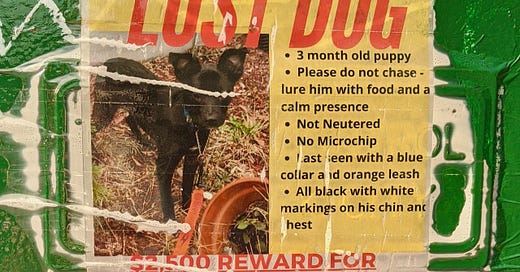






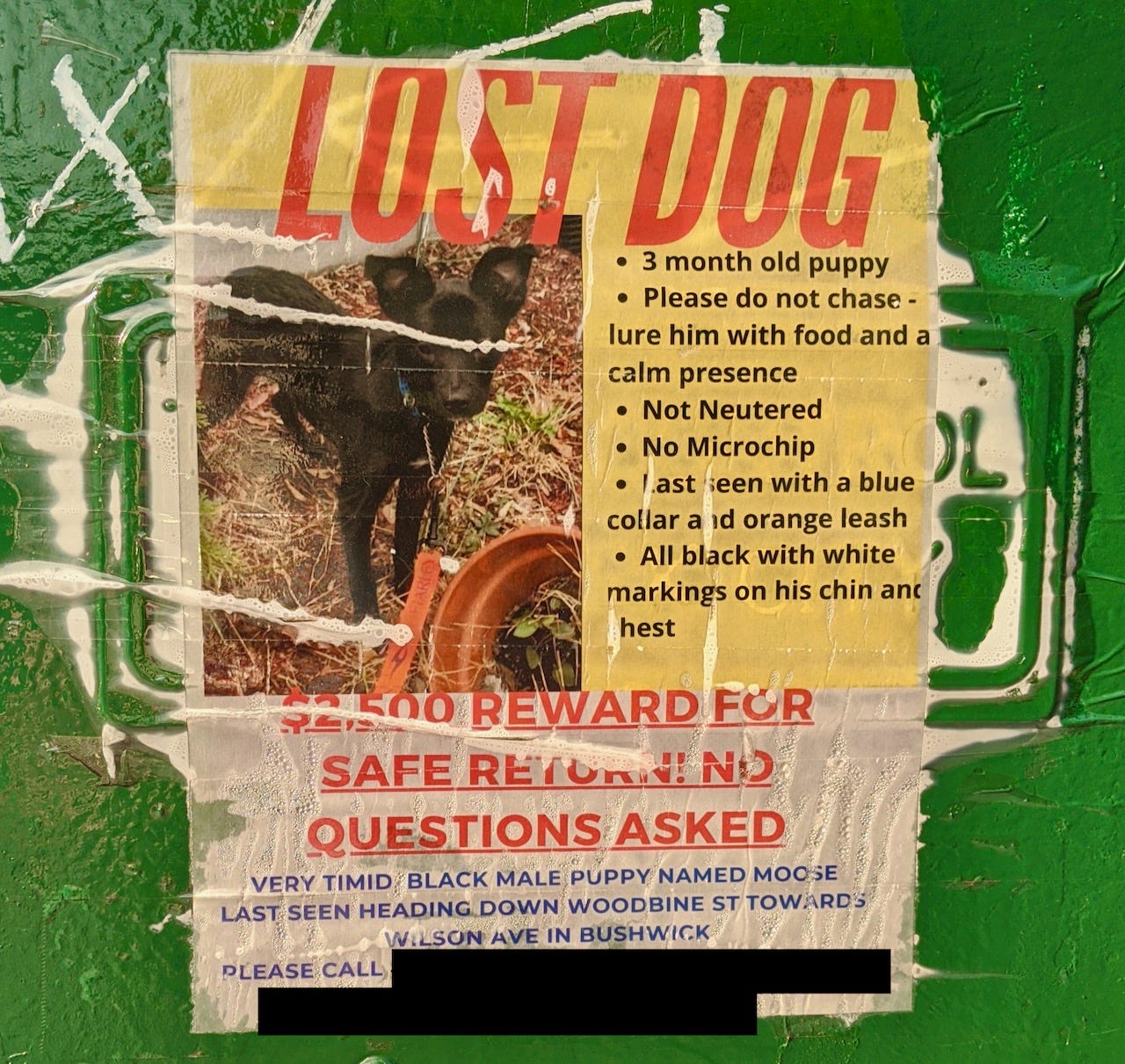




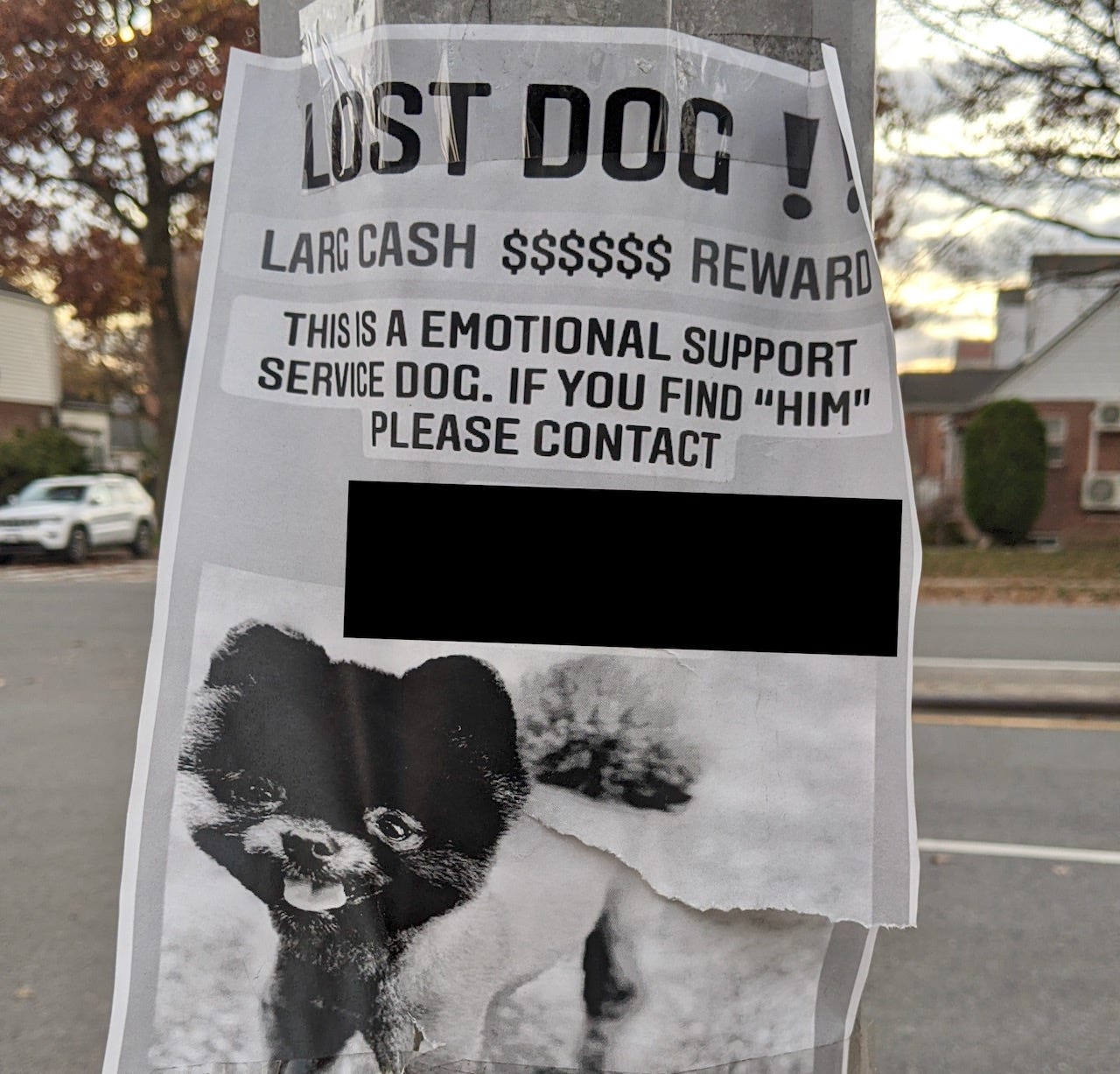
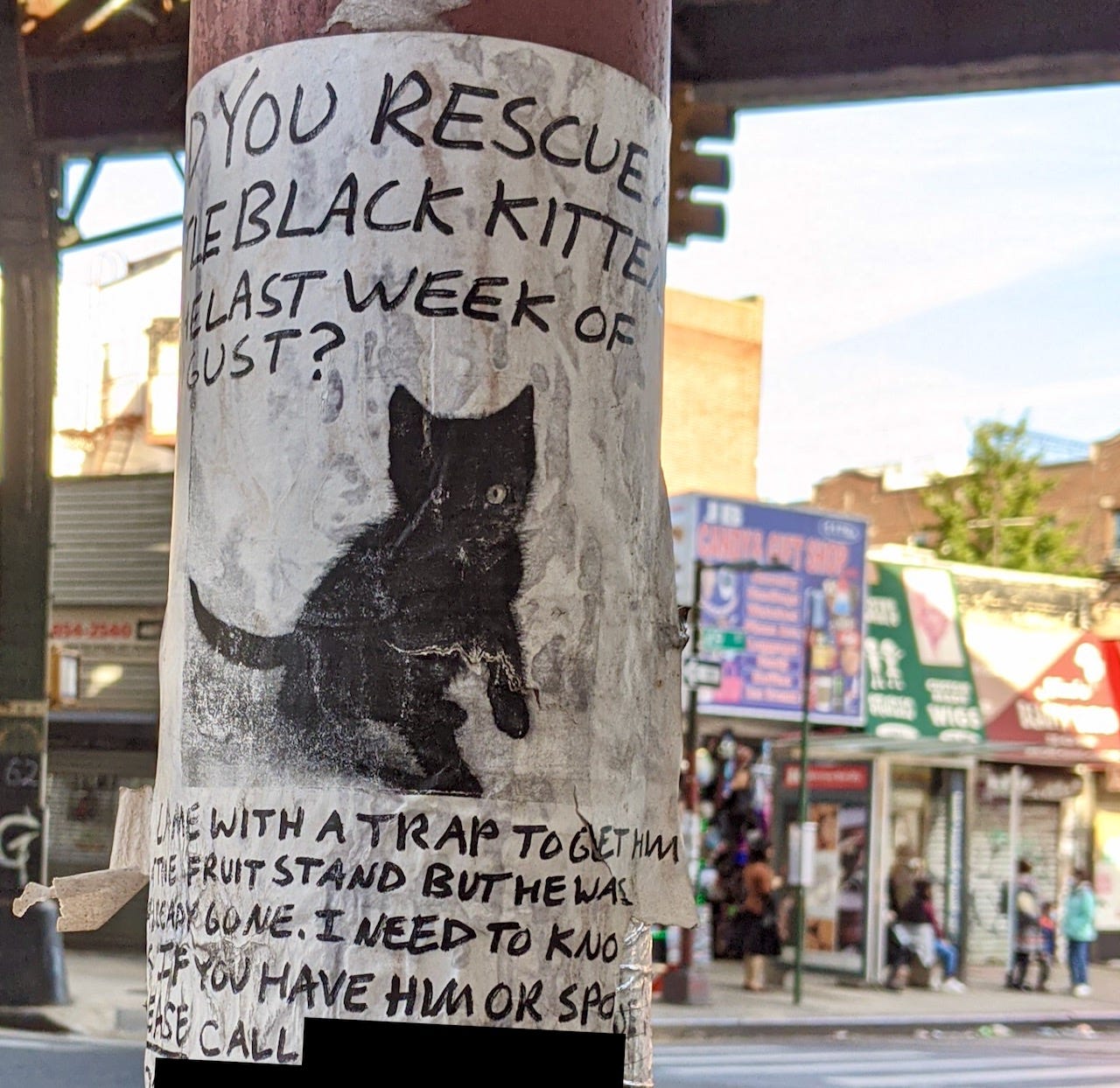

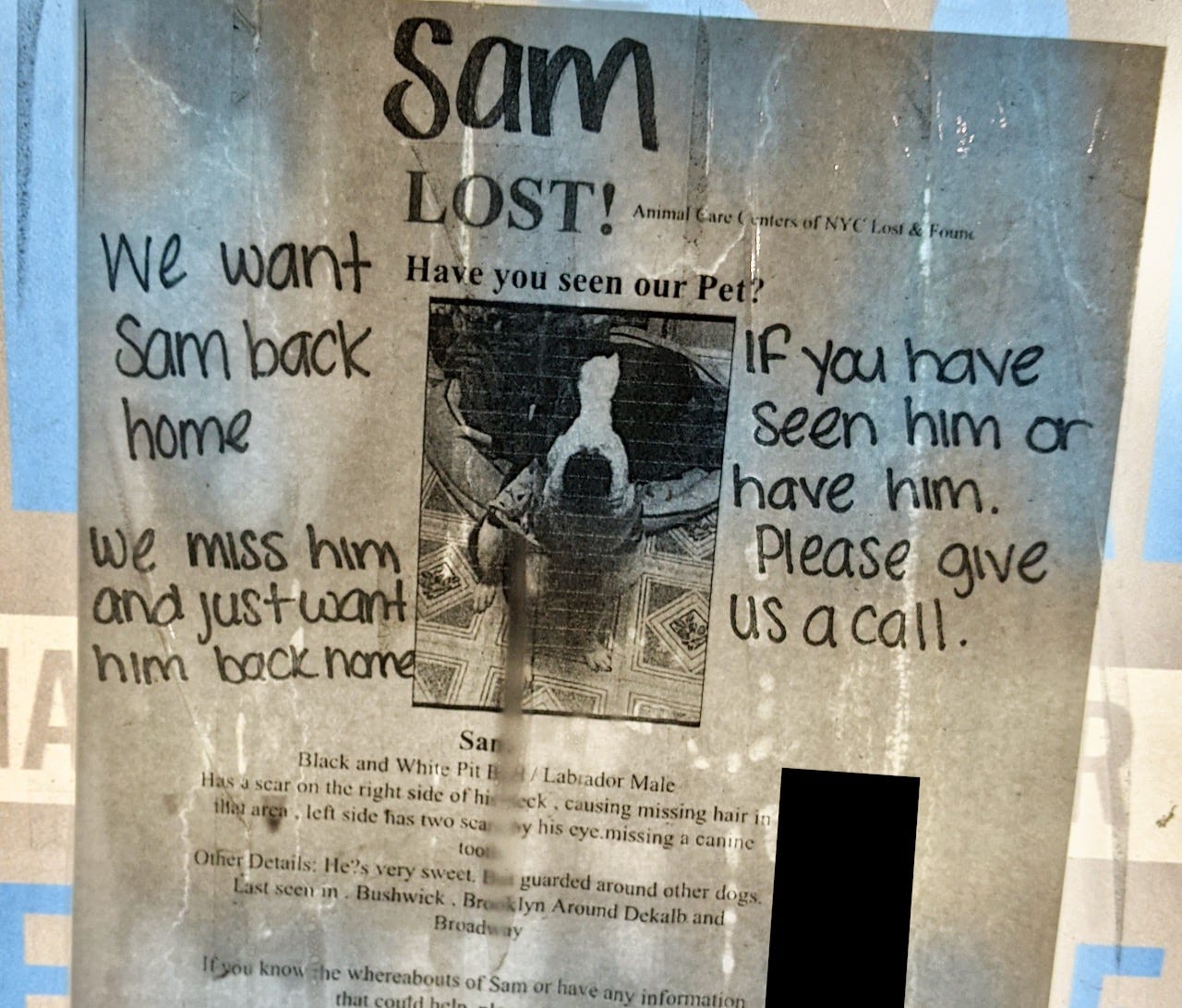

Can't wait for those pics of stuff stored in ovens! Brilliant idea.
Another brilliant idea: lost pet posters. I love that.
I think you & Alex should team up for messy ass spaces. Your spin: messy ass ovens! I’ve never done it but I remember when I was in grad school, people stored their books(!) in ovens. Seemed like an appropriate reflection of our mental state at the time 😂